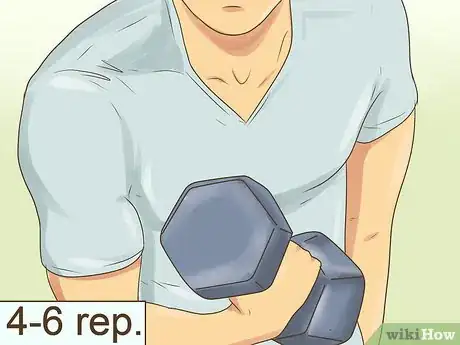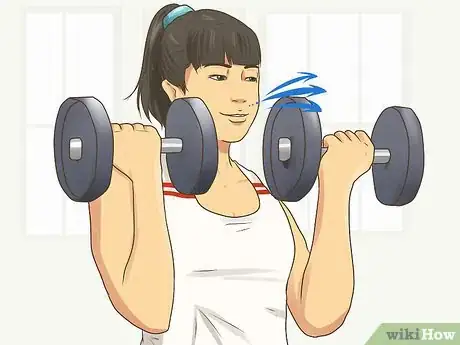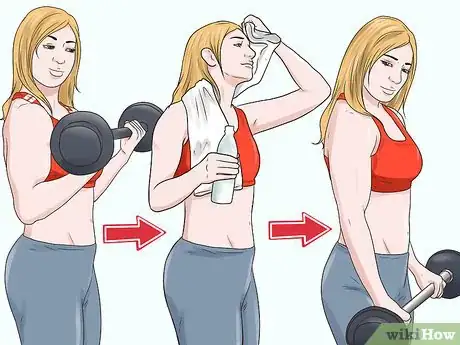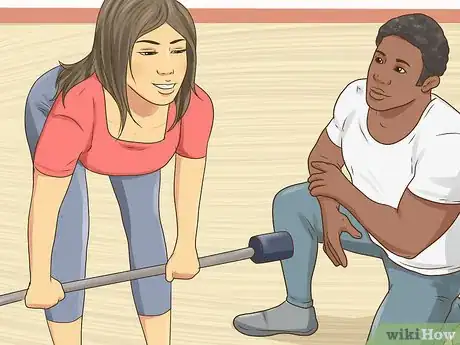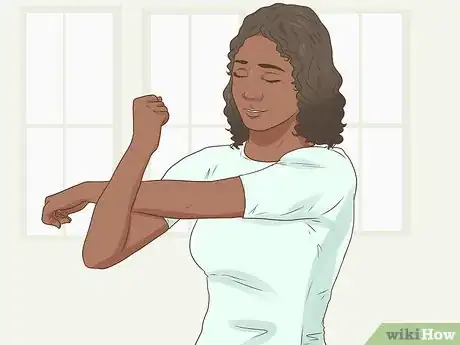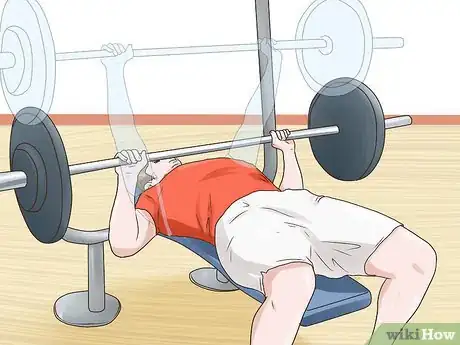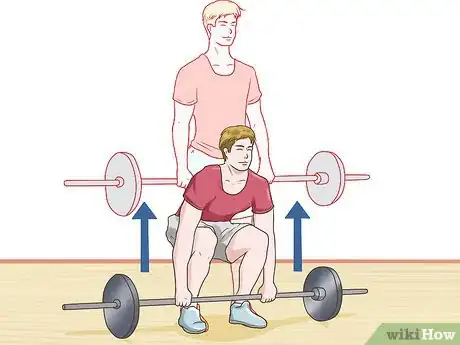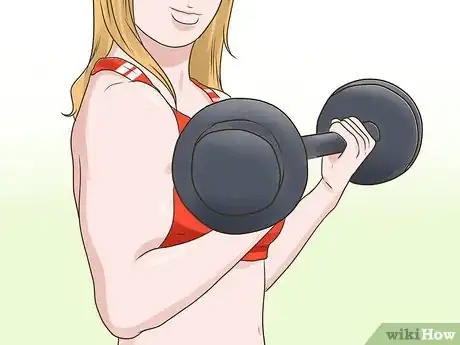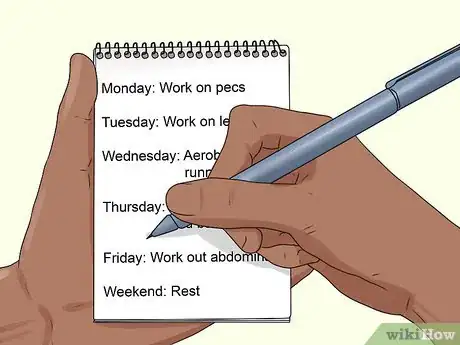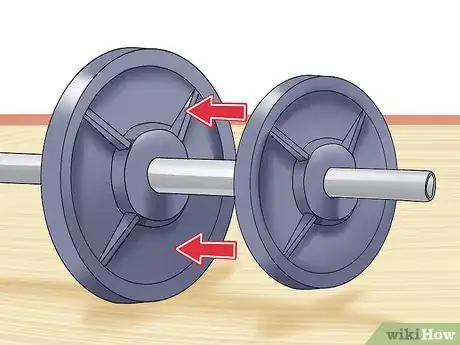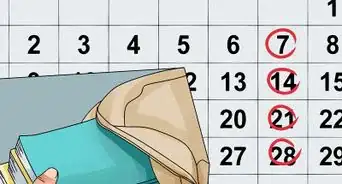This article was co-authored by Laila Ajani. Laila Ajani is a Fitness Trainer and founder of Push Personal Fitness, a personal training organization based in the San Francisco Bay Area. Laila has expertise in competitive athletics (gymnastics, powerlifting, and tennis), personal training, distance running, and Olympic lifting. Laila is certified by the National Strength & Conditioning Association (NSCA), USA Powerlifting (USAPL), and she is a Corrective Exercise Specialist (CES).
This article has been viewed 63,405 times.
Just as when you're moving heavy objects around the house, you need to learn proper lifting technique at the gym. Lifting correctly means using the proper form and motions, maximizing reps and staying safe by performing exercises slowly and intelligently. You can learn to target your core muscle groups to build muscle the right way, lifting carefully and correctly.
Steps
Using Proper Lifting Technique
-
1Always warm up with a quick routine before you lift. It's important to oxygenate your bloodstream, loosening up your muscles, warming them up, and getting them ready for heavy lifting. If you want to build muscles and avoid injuries, warming up is essential.
-
2Stretch your muscles with dynamic stretches before a workout. It is important that you dynamic stretches and not static stretches. Dynamic stretches are moving stretches, whereas static stretches you hold a stretch in place. Studies have shown dynamic stretches to improve strength for workouts and reduce susceptibility to injury, while static stretches before a workout have been shown to weaken the muscles. An example of a dynamic stretch is arm swings. Swinging your arms up and down the full range of movement stretches the deltoids (shoulders), this would be ideal to do before say, shoulder press.Advertisement
-
3Choose the right amount of weight. Ideally, you want to lift the most amount of weight you can manage for the amount reps that you intend to do. It is important to prioritize achieving the required rep count rather than sacrificing more than 3 reps so you can show off lifting heavier weights. This is known in gym culture as leaving the ego at the door. Having the discipline to resist going too heavy is a skill, and if you resist and stick to doing as much weight as you can for the amount of reps you need, you will make progress faster, because the number of reps you do determines how your muscles adapt.
- Trial a moderate amount of weight and make sure you have the form/movement correct. If you feel you can do more for the amount of reps you are aiming to do, go heavier. Once you find the maximum amount you can manage for the amount of reps, stick with that. Next workout try adding a bit more weight.
- Lifting weights that are too heavy to achieve the rep range you need is a bad idea, and you will look silly and like you trying hard to impress to any experienced lifters in the gym, so don't bother. Ideally you should not attempt weights that are too heavy for you to finish the reps by yourself/without a spotter. If you need a spotter to help with a couple of reps, it means you picked a weight which is too heavy for you to finish the reps, and you need to lower it until a time where you are strong enough to manage the higher weight without assistance. Lifting weights that are too heavy is also one of the most common causes of injury in the gym, and there's plenty of compilations videos on the internet to give you an idea. Lifting weights that are too heavy can also serious strain and even damage your joints/cartilage. Joint/cartilage take longer to build/strengthen/adapt to training than muscles.
-
4Determine what rep range you need to hit, and stick within that range. Different goals demand different amounts of reps.
- For strength, you should be aiming for 4-6 repetitions.
- For muscle hypertrophy (building bigger muscles) you should aim for 8-12 reps.
- For muscle endurance you should aim for 15-20 repetitions.
- Different rep ranges also changes the energy system the body uses to supply the muscles. Lower rep sets use the adenosine triphosphate/phosphocreatine (ATP/PC) system. Higher reps use the aerobic energy system.
- Performing a One Rep Max, or lifting the max amount of weight you can for a single repetition, can be invigorating and fun to show off, but should be used only as a point of measurement. In weightlifting, weights are often noted as a percentage of your 1RM (One Rep Maximum). For example if you could perform 100kg as your maximum for one repetition of bench press, then you lifted 75kg for 8-12 reps, you would be lifting 75% of your 1RM.
EXPERT TIPLaila Ajani is a Fitness Trainer and founder of Push Personal Fitness, a personal training organization based in the San Francisco Bay Area. Laila has expertise in competitive athletics (gymnastics, powerlifting, and tennis), personal training, distance running, and Olympic lifting. Laila is certified by the National Strength & Conditioning Association (NSCA), USA Powerlifting (USAPL), and she is a Corrective Exercise Specialist (CES).Fitness Trainer
 Laila Ajani
Laila Ajani
Fitness TrainerOur Expert Agrees: If you want to increase your muscle size, focus on doing more reps—between 10 and 20, for instance. However, if your focus is mainly on building strength, do 3-8 reps with a higher weight.
-
5Complete the movement all the way just before you lockout the joint(s) being used. The proper lifting technique for each exercise differs slightly--you wouldn't use the same form for a bench press as you would for a dead lift--but what each lift has in common is that you need to extend and complete the motion all the way before you lockout. A bench press needs to come all the way down to your chest, and needs to extend to just before your elbows lockout.
- Do not lockout in any exercise. Firstly because, depending on the exercise, locking out can severely damage the joint(s) being used, especially with heavier weights, because it shifts the weight from the muscles the joint(s) For example with leg press, leg press will use one of the biggest amounts of weight of any exercise. If you full extend and lockout your knees, all the weight is shifting from the muscles to the knee joint. So you can see how that is damaging. Secondly, when you lockout you are taking the the strain off the muscles and putting it onto the joint, meaning your muscles are getting rest and making easier to do the exercise. Resisting from locking out will result in the exercise working the muscles much better. For example in a standing bicep curl, do not bring you hands all the way down, bring almost all the way then go back up, this prevent your biceps from getting unnecessary rest between reps.
-
6Consider your rep tempo. Determine how much time your reps should take for your goals. Different amounts of time for reps are used for different aims. For strength, the concentric phase (muscle contraction) should be explosive and push up in 1 second, and the eccentric phase (muscle lengthening) should be slow, about 3 seconds. For muscle hypertrophy (growing bigger muscles) It should be 3 seconds concentric and 3 seconds eccentric. More time under tension breaks more muscle fibers, which is what you want if you are trying to gain muscle size. For muscle endurance, obvious a faster rater is used, about 1 second concentric and 1 second eccentric.
- To clarify what is meant by concentric and eccentric, this is the two phases of lift, where muscles contract/short, then lengthen. For example in a bicep curl, the concentric phase is when you lift up and shorten the bicep. In a tricep rope pull down, the concentric phase is when you pull down and shorten the tricep.
- Strength: 1 second explosive contraction - 3 seconds eccentric
- Muscle Hypertrophy: 3 seconds concentric - 3 seconds eccentric
- Muscle endurance: 1 second concentric - 1 second eccentric.
- Do not pause during a set, keep the tension on the muscles and don't lockout the joint being used.
- To clarify what is meant by concentric and eccentric, this is the two phases of lift, where muscles contract/short, then lengthen. For example in a bicep curl, the concentric phase is when you lift up and shorten the bicep. In a tricep rope pull down, the concentric phase is when you pull down and shorten the tricep.
-
7Breathe. You need to supply your muscles with oxygen just like you would if you were going running. For any weightlifting, you should breathe out on the concentric phase, and breathe in on the eccentric phase. So for example in a bench press, you would breathe out as you push the weight up, then breathe in as you lowered the weight back down. In a barbell row, you would breathe out as you pulled the weight up, and breathe out as you lowered it back down. Breathing properly is extra important with heavier lifts and with lifts that use the legs (because the leg muscles demand a lot of oxygen) For example in deadlifts and in squats, proper breathing is essential, not doing so can lead to lightheadedness, palpitations, dizziness, and even fainting. [1]
-
8Rest between sets and between exercises. Different goals also require different rest times:
- Strength: rest 2-4 minutes between sets
- Hypertrophy: rest 1-2 minutes between sets
- Endurance: rest 30-60 seconds between sets
- Between exercises where you are using the same muscle(s), rest at least 3 minutes. 2 minutes rest is sufficient if moving to an exercise using different muscles. More rest may be needed for the more demanding lifts like squats and deadlifts in order to allow your Central Nervous System to recuperate. If you find you are starting to get dizzy/palpitations/lightheaded progressively after sets of squats or deadlifts, try resting a bit longer, for at least 2 minutes.
-
9Always lift with a spotter when doing exercises that are dangerous. If you don't have a friend to help re-rack the weight at the end of a set, for example benchpress, you may struggle to push up and re-rack the weight. If you don't have a spotter there then you'll be in trouble, it will be dangerous and embarrassing. Never exercise alone in general, if you run into complications you need to have someone around to help/get help if needed. If you come to an empty gym, either don't train, or be extra safe during your workout and don't push too hard, and use assisted racks for exercises like bench press and squats so you can easily re-rack the weights without help.
-
10Do static stretches after a workout to cool down. As a cool down, you might have a specific activity or exercise that you like to do. Doing some static stretches and letting your body finish exercise slowly will make it much less likely that you'll be sore the next day, decreasing the possibility of injury or pulled muscles.
Targeting Core Muscle Groups
-
1Work out your pecs. The pectoral muscles, the muscles that extend from the top of the shoulders across the chest, can be exercised by lifting free weights or flyweights in a flat or inclined "push up" motion.
- The bench press is the most famous lift for a reason: laying on your back, usually on a weightlifting bench, you want to grab the bar shoulder-width apart. Plant your feet on either side of the bench, unpack the bar and position it (with the help of a spotter, as always) over your chest, keeping your muscles tight. Lower the weight slowly until it touches your chest, then push up forcefully, driving back and extending into the "top" or "up" position.[2]
- Dumbbell presses involve a similar technique to the bench press, but use individual dumbbells in each hand.
- Chest curls are likewise similar, though you'll keep your arms straight and extend them outward, like a bird flapping wings.
-
2Work out your back. Using free-weights is an excellent way to strengthen your back, resulting in a toned physique and over-all strength and definition. Working out your shoulders and back muscles is essential in any total lifting routine.
- Do deadlifts. Deadlifts are a more advanced lift, and should only be completed with the aid of a spotter or a trainer who can assist you. It can be quite dangerous to deadlift if you don't know what you're doing, because it involves lifting the bar up from the ground, and powering it into an upright position. In some forms, you'll lift it to your chin, or up above your head.
- Do dumbbell rows. Working one arm at a time, from a kneeling position on a weight bench, lift one dumbbell from the ground up to your chest before lowering it to complete the rep, then alternate sides.
-
3Build your biceps. If you want to cash in your tickets to the gun show, start lifting to target your biceps and get them both bigger and stronger.
- Do bicep curls to build your biceps, either from a standing or seated position. Letting an appropriately-weighted dumbbell hang at your side, bring them to your chest by flexing your bicep. Alternate arms to complete the workout.
-
4Do squats. Don't neglect your legs, which make up a large and easy-to-neglect muscle group that you can work with free-weights. To do squats, you'll take the bar at a squat-station onto your shoulders, holding it securely behind your head, and squat down, keeping your back very straight and then driving back up.
Building a Training Regimen
-
1Vary your work out. If you do nothing but bench presses all week, you're not lifting correctly. Create a routine that varies the muscles you'll work on throughout the week, shaking it up while still highlighting the muscle groups that you're targeting and strengthening with your good technique. A weekly regimen might look something like this:
- Monday: Work on pecs
- Tuesday: Work on legs
- Wednesday: Aerobics and running
- Thursday: Work out torso and back
- Friday: Work out abdominals.
- Weekend: Rest
-
2Gradually add a comfortable and small amount of weight. With the proper technique, you should start to notice your regular routine get a little easier, which means you're getting stronger and starting to build muscle. Lifters call this a "plateau" and use it as a sign that it's time to start adding weight and varying the routine, to avoid flattening out.
- To add weight, use weights which are still comfortable, but heavy enough to make those last few reps more difficult, finding that sweet spot, where the muscles almost fail.
-
3Keep doing pyramid sets and vary your rests. To really start varying your work out and introduce a cardio element into the workout, you can mess with the amount of time you take to rest between your sets. If you're giving yourself a full minute between sets for your arm, cut it down to 15 or 30 and notice how much more difficult it becomes.
- Listen to your body and don't rush yourself. Jumping straight into another set when you're exhausted is a good way to make a mistake and cause an injury. Be careful and train at your own pace.
-
4Only lift a few times a week. It's a common mistake that rookies in the gym think lifting out three times a day is the quickest way to build strength and definition. This is not the case. Over-training can result in injury, keeping you sidelined from being able to work out properly for weeks or even months at a time. Lift correctly a few times and you'll start building muscle more quickly than you will lifting too often.[3]
-
5Heat down after you cool down to deal with the soreness. After you finish your work out, always take a hot shower or bath. Steam-rooms are also popular after-workout routines, letting your muscles stay warm and "cool down" at their own pace. You'll notice your muscles will be less sore with the proper after-workout care.
Expert Q&A
-
QuestionHow should I lift weights to build muscle?
 Laila AjaniLaila Ajani is a Fitness Trainer and founder of Push Personal Fitness, a personal training organization based in the San Francisco Bay Area. Laila has expertise in competitive athletics (gymnastics, powerlifting, and tennis), personal training, distance running, and Olympic lifting. Laila is certified by the National Strength & Conditioning Association (NSCA), USA Powerlifting (USAPL), and she is a Corrective Exercise Specialist (CES).
Laila AjaniLaila Ajani is a Fitness Trainer and founder of Push Personal Fitness, a personal training organization based in the San Francisco Bay Area. Laila has expertise in competitive athletics (gymnastics, powerlifting, and tennis), personal training, distance running, and Olympic lifting. Laila is certified by the National Strength & Conditioning Association (NSCA), USA Powerlifting (USAPL), and she is a Corrective Exercise Specialist (CES).
Fitness Trainer
Warnings
- Preferably don't work out in an empty gym so if you have some sort of health problem someone can help, and select a gym that has a working defibrillator, in case you or anyone else has unexpected heart problems during a workout.⧼thumbs_response⧽
- Don't even consider using steroids if you're learning new things in this article. It's a lot more complicated and harder to manage than you may think it is, and you should train to your maximum potential before even considering that option, because your natural testosterone levels will likely never completely return to the level they were at before you used any steroids, meaning you're going to need to take more. Have patience and train hard, eat a proper diet from a sports dietitian, and get enough sleep.⧼thumbs_response⧽
- Get screened by a qualified personal trainer before you even go out to do the first workout. They will determine with a screening guideline, doing things like taking your blood pressure and you resting heart rate, whether you need a doctors clearance to work out or not, and to what intensity of workout you can safely do. This is very important because it can prevent health problems being triggered from exercising, especially for older people.⧼thumbs_response⧽
- Bending at the waist without bending your knees before lifting an object will place undue strain on your lower back and put you at greater risk for back injury.⧼thumbs_response⧽
- You may like to do a first aid course, so you can help someone if they injure themselves or have a serious health problem in the gym. Knowing how to do CPR and use a defibrillator can make the difference between saving someones life or them dying while you remain helpless.⧼thumbs_response⧽
- Don't lift heavy free barbells that need to be re-racked at the end of a set without a spotter. This was already mentioned in the page, but it deserves to be said twice. You'll look really silly and pathetic if can't get the barbell back onto the rack at the end of a bench press, and you could serious hurt yourself if no one is there to run over and help get the bar off you, especially if it falls on to your neck.⧼thumbs_response⧽
- Be careful using stimulants of any kind before a workout, whether its a coffee or a pre-workout supplement, especially if you have ANY level of heart problems. People have different sensitivities to stimulants because of genetic differences in liver enzymes. What may be rather low for one person in caffeine can be a lot for another person. Over stimulating the cardiovascular system while working out can permanently damage the heart.⧼thumbs_response⧽
References
About This Article
To lift correctly, always warm up first with a few basic exercises, like push ups and sit ups, to help loosen up your muscles and prevent injury. When you're ready to get started, choose the most amount of weight you can manage to lift for the number of reps you want to do. Avoid lifting weights that are too heavy for the number of reps you want to do since you can seriously injure yourself. If your goal is to build strength, stick with 4-6 reps of each exercise. If you want bigger muscles, try 8-12. To learn how to target different muscle groups while lifting, scroll down!



